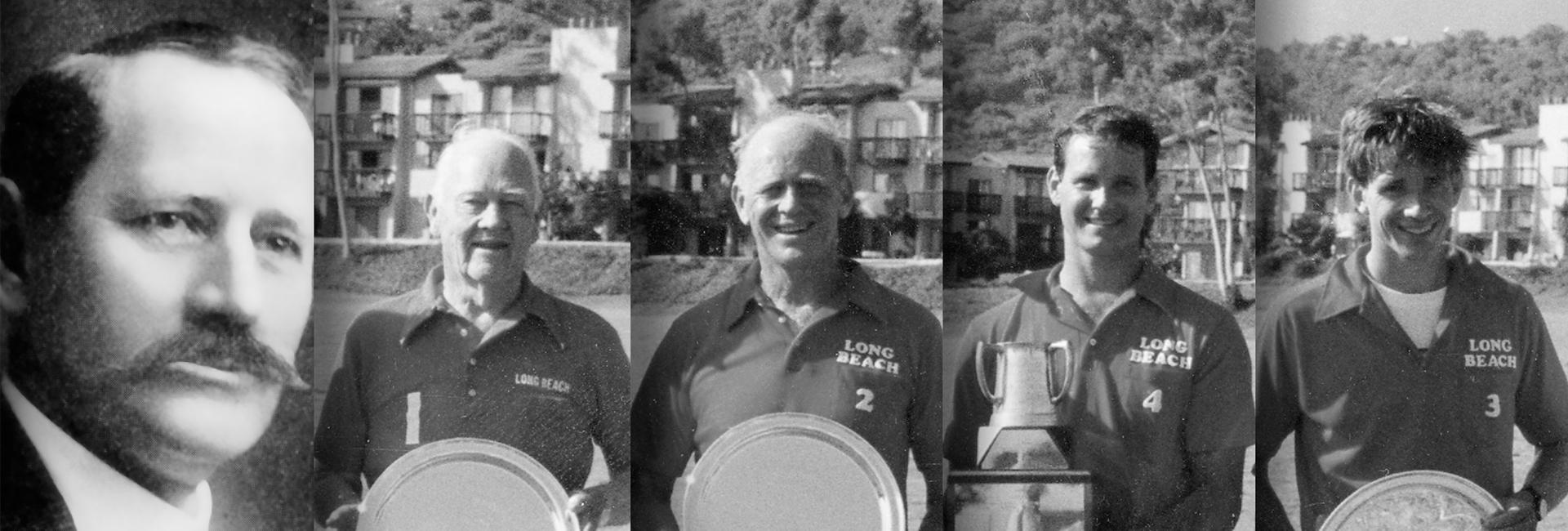 Available
Available
 Lottery
Lottery
 Lottery Requested
Lottery Requested
 Future
Future
 Reserved
Reserved
 Wait List
Wait List
 Unavailable
Unavailable
Upcoming Events
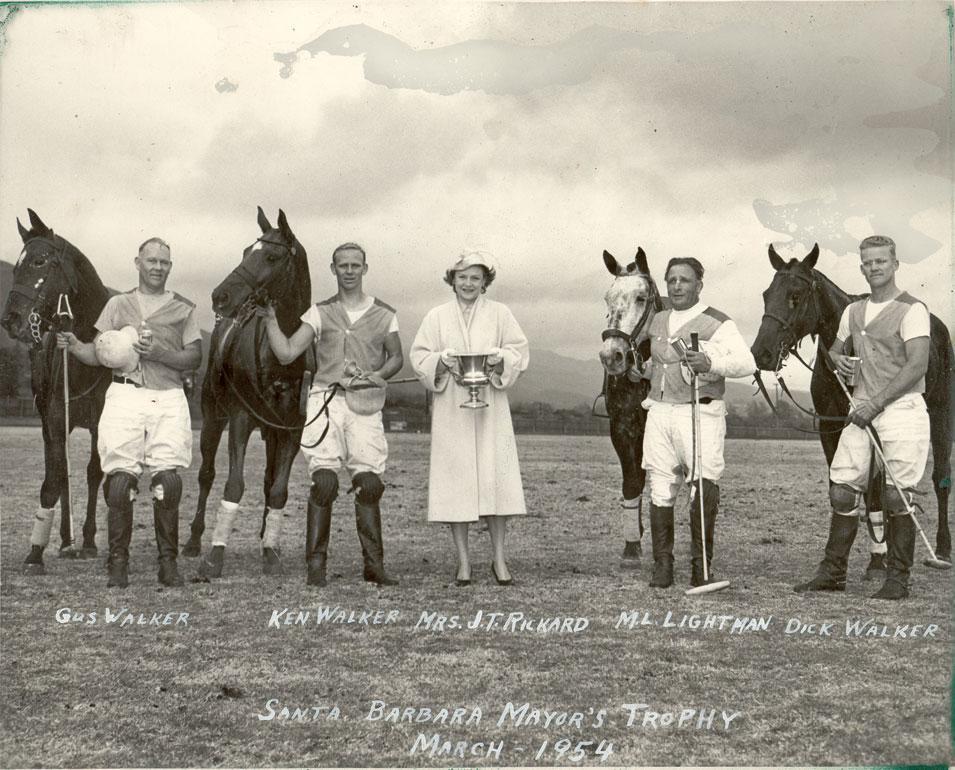
Polo Is A Legacy For The Walker Family
by Linda L. Walker
A legacy is not bound by age or by a certain time that it is served. Webster's dictionary defines legacy as, "anything handed down from the past, as from an ancestor or predecessor." A legacy represents a person's body of work at each new stage of their career or sport as they establish foundational building blocks to accumulate the required wisdom to grow and innovate into a new and different level. A legacy grows with each new experience, untested idea or bold ideal that can be expressed and inspire others to see something to fruition. Leadership done right is the reinvention process that can lead to a legacy. Polo is a legacy sport.
In 2021, the Santa Barbara Polo and Racquet Club will be celebrating its 110th anniversary, a true milestone for the SBPRC. This would not happen without the legacy of the Walkers. Their polo legacy all started with Gustavus Arthur Walker.
It was into this world that Gustavus Walker was born in Long Beach, 1899. He was the third child of a tough and humble businessman from New York named Charles J. Walker. C. J. Walker became mayor of the City of Long Beach and founded Farmers and Merchants Bank of Long Beach in 1907. Gus paid attention to business and his family for the first 35 years of his life. But he always made time to ride horses with his friends at the nearby Lomita Riding Club in Long Beach. One fateful day, someone introduced this group to the sport of polo. The group was short of polo equipment, and they had no clear idea regarding the rules for the game. Polo was going to be their fun for that day. The men did not have any mallets so they decided to use make-shift brooms as mallets for fun. What fun they all had!
Polo completely captivated Gus from that day forward. He set out to exchange many of his cowponies for thoroughbred horses. During this time, horses and riding were commonplace. Gus's son, Ken started to play polo when he was barely 11 years old. One of his first memories was a tournament at the Riviera Polo Club in Los Angeles against a team with Spencer Tracy's son, John. This was a time when celebrities where an integral part in the sport of polo. Big names like Walt Disney were common place at the polo fields.
Polo soon dominated the Walker family's life. They decided to move their horses closer to home near Long Beach to the Hellman Ranch in Seal Beach. The Hellman Ranch had been purchased by I. W. Hellman in 1886. I. W. Hellman was a German born Jewish banker, philanthropist and a founding father of the University of Southern California. He was the founder of Farmers and Merchants Bank of Los Angeles in 1883. At one time the Hellman Ranch was over 6000 acres extending from Seal Beach to Garden Grove Boulevard. The Hellman Ranch was divided into large parcels of land that were farmed mostly by immigrant farmers. They worked part of their parcels as a cash crop for themselves, and the rest of the parcel was used to produce barley hay for the Hellman cattle. One of the largest cash crops grown on this ranch was sugar beets. There were two sugar beet processing plants; one was located in Los Alamitos and the other in Santa Ana. Today, the Hellman Ranch has been developed into the Naval Weapons Station, Leisure World, Rockwell/Boeing Company, the Police Department, the housing track of "The Hill" and the housing track of "Heron Point."”
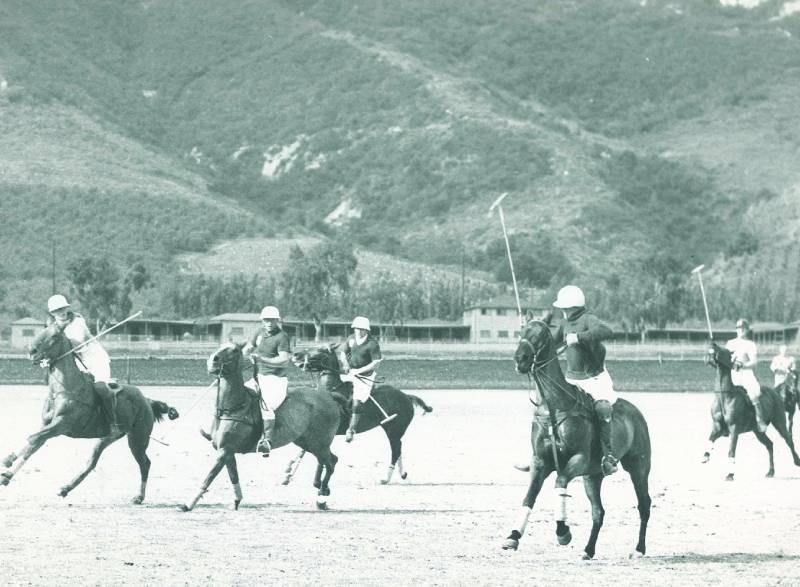

It was at this ranch that John Walker, Ken's oldest son, was taught about horses and polo from his father. John, only eight years old in 1957, can remember that he and his brother Howard learned to ride and care for their horses here. They would arrive to the Hellman Ranch from church in order to roll all the bandages for the horses. Once the horses were bandaged the young boys would load the horses into a seven- horse van and a two- horse trailer. The Walker boys all traveled together by truck to the Garden Grove field for the polo game.
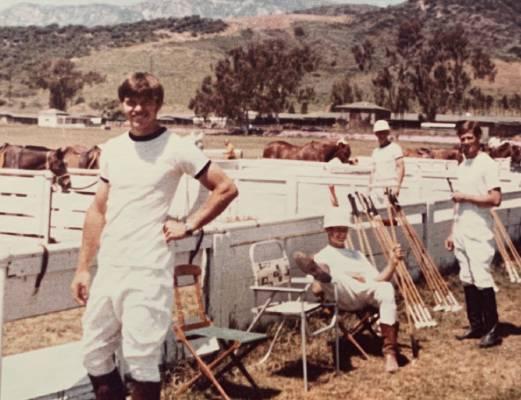
This was a great family Sunday afternoon. The Valencia Polo Club is where John as young teenager was able to play his first two chukkers of polo. In 1981, John Walker was rated three goals. The USPA player that inspired him the most was Robert Skene. Mr. Skene would always come on the field with a gentle touch and yet score at will.
This field in Garden Grove was called the Valencia Polo Club. Polo was played here from 1953 to 1964. There were recognized ten goal tournaments that were played at the Valencia Polo Club. The field was located on the corner of Cannery Ave. and Garden Grove Blvd. The Valencia Polo complex was owned and operated by Beuila and Harry Marrell. There were many jobs that were available for both boys and girls before, during and after the Sunday polo games. All jobs paid 50 cents for a day's work.
Gus and his two sons, Ken and Richard "Dick", pursued their passion of polo at the Riviera Polo Club, Garden Grove (Valencia Polo Club) and Palm Desert. The Walkers' involvement in polo continued until the beginning of World War II in 1941. During 1917, Gus Walker did serve in the military valiantly. He fought in World War I after United States declared war against Germany on April 6, 1917. Gus was sent and fought on the bloody fields of France, fighting the Central Powers. During World War II, as able-bodied citizens, both Richard "Dick" and Ken were called into the military. Polo life for the Walkers ended as the war took over. Richard Walker's service in the U.S. Army started in 1942. Kenneth Walker's service in the U. S. Navy started in 1944. At the heart of Farmers and Merchants Bank legacy of service lies an unbridled love for our country. Gus Walker's sense of duty and patriotism first are values of leadership and vision that he guided into his sons and his family.
At the end of World War II, there was a slow resurgence back to the sport of polo. The Santa Barbara Polo Club in Carpinteria marked the return of polo to its fields again. During World War II, the Santa Barbara Polo Club was home to various troops, and the polo fields were used to train on them. This war effort caused the grass fields to turn into dust. Once World War II was over, the troops left, and the grass returned. Polo could now return to the Santa Barbara Polo Club.
It was 1950, and it marked an era when anything seemed possible. Ken ferried his family up the coast from Long Beach to Carpinteria in his 83- foot AVR boat. He moored his boat off Santa Claus Lane and rowed his wife, Nancy, and their two young sons, John and Howard, to shore to play polo. Polo players often had exciting adventures and went to the Walker boat for parties and excursions.
Dan would be born in 1954. His birth created a dream for an all - Walker polo playing team for Ken. It would just take time and patience to develop and let Dan grow up. Dan can still remember when he was only six years old that his father lifted him onto the back of a gelding named Ray Dab at the Hellman Ranch. On his second ride, he was lifted onto the back of a gray mare named Molly. Both of these rides were so exciting to Dan. They marked the life time memories for Dan that created his commitment to horses being in his life forever. Dan can still remember the Hellman Ranch and Valencia Polo Club days. These were the days that boys dream about. The fun- filled time with family spent riding horses and sitting in the truck together. Dan can remember his mother taking a whole loaf of white bread out and making peanut butter and grape jelly sandwiches. She would then place them all back into the plastic bread sleeve. When you were hungry, you pulled out a P & J. When you were thirsty, you drank straight from the hose. If the Walker polo team won, that was a really special time. It was an A & W root beer time!
During this time the Walkers maintained a string of 11 to 14 polo ponies. This seemed like enough horses for the three of them to play the sport. Then they realized that teams like the Linfoots were winning most of the games. The Walkers seemed to get beat in the last chukkers due to the lack of depth of their strings. The Linfoots had many more horses with fewer players.
Ken then acquired King's Fare, a stallion by the Champion Warfare, out of a stakes winning and producing daughter of Hyperion. The Walkers started to breed all their own polo ponies. This helped to change their polo future and give them more horses to play the game. Soon there would be an all- Walker team for polo.
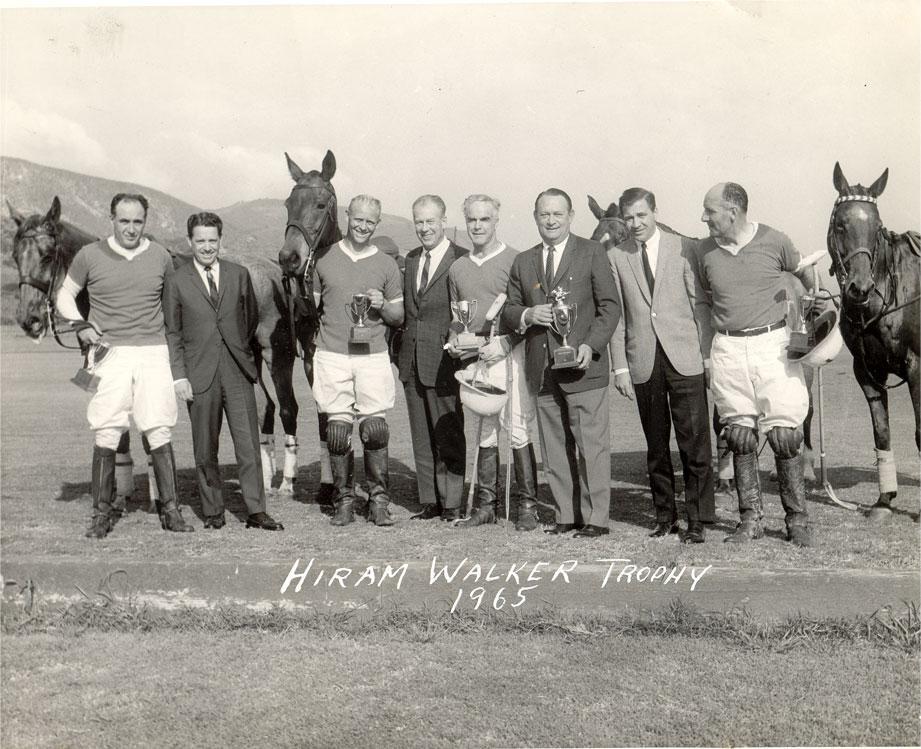
In 1962, Ken, John and Howard were playing polo at the Santa Barbara Polo Club. Dan was only eight years old then. Dan was given a job to hot- walk all their polo ponies after each chukker. He soon realized that he needed to ride to be just like them to play polo. He started to teach himself how to ride on a gelding named FriSun . Soon after starting to ride, Dan began to teach himself how to stick and ball. After he finished his hot- walking job for the family, he would grab a mallet and stick and ball until the end of the day. Following his long stick and ball sessions, he would take FriSun for one last lap around the track to win the race of the day. Dan had to prove to his family that he could ride with his older brothers.
Next year, Ken Walker bought the Dodge Ranch in Lassen County. This ranch was a cattle ranch that was 20 miles square in acreage. Polo for the Walkers was replaced with gathering cattle from 1963-1969. Dan was only nine years old, but he did not want to be left behind because of his age nor his size. They all gathered cattle together every weekend until the ranch was sold in 1969.
Dan was given a mare for his 16th birthday named Melissa at the Santa Barbara Polo Club. Not long after getting his mare, he was asked to come play at "Pete" Jackson's polo field. The Jacksons had a requirement for Dan that he had to ride Melissa back and forth over a large dirt hill to play at their field.
They did not want him to trailer to their facility. They also wanted Dan to play two straight chukkers. Melissa was considered to be one of his best horses. Melissa was an iron maiden polo horse. Dan has been lucky to have many talented polo ponies. But his two exceptional horses were Secretary and Santiago. Dan has had various handicap ratings as well. His highest rating was five goals in 1988 and today he has a two- goal handicap. Dan's favorite memory is winning both the 2017 and 2019 Pacific Coast Open Championships. The USPA player that Dan admires the most is Lucas Criado.
Next year, Ken Walker bought the Dodge Ranch in Lassen County. This ranch was a cattle ranch that was 20 miles square in acreage. Polo for the Walkers was replaced with gathering cattle from 1963-1969. Dan was only nine years old, but he did not want to be left behind because of his age nor his size. They all gathered cattle together every weekend until the ranch was sold in 1969.
Dan was given a mare for his 16th birthday named Melissa at the Santa Barbara Polo Club. Not long after getting his mare, he was asked to come play at "Pete" Jackson's polo field. The Jacksons had a requirement for Dan that he had to ride Melissa back and forth over a large dirt hill to play at their field. They did not want him to trailer to their facility. They also wanted Dan to play two straight chukkers. Melissa was considered to be one of his best horses. Melissa was an iron maiden polo horse. Dan has been lucky to have many talented polo ponies. But his two exceptional horses were Secretary and Santiago. Dan has had various handicap ratings as well. His highest rating was five goals in 1988 and today he has a two- goal handicap. Dan's favorite memory is winning both the 2017 and 2019 Pacific Coast Open Championships. The USPA player that Dan admires the most is Lucas Criado.
John's favorite polo pony was named Harry. Harry was raised by his father at their Huasna Ranch. John gave the horse his name after Harry Hicks, who built the Santa Barbara Polo condos in 1974.
One of Ken's fondest memories of polo is a game that was won against the Conant family and the Crescents Polo Team on Easter Sunday in 1969. This was an all- Walker six player game. Ken, Richard "Dick" and Howard Walker played six continuous chukkers. Then John, Dan and Rick (Dick's oldest son) Walker played two chukkers each as the fourth player on the Walker team. This winning game represented a true Walker family team effort.
Howard Walker had a two- goal handicap, and he seemed to have great polo potential for the advancement within the sport. Howard was captivated by the sport of polo, and he loved his horses. But a tragic ranching accident in which he was buried alive over Labor Day took his life in 1973. He was only 22 years old.
With the birth of Henry in 1965, the Walker family again looked forward to an all-Walker polo team. Henry first started riding at eight years old at the Madeline Ranch in Lassen County. His favorite memory as a young rider is with Chava Gonzales and the family horse, FriSun. Henry was nine years old at the Santa Barbara Polo Club when he decided to walk FriSun onto the track that day. FriSun's walk turned into a full speed gallop around the track. Soon Henry was out of his saddle and had his legs locked around FriSun's neck! It was Chava Gonzales who came to Henry's rescue. Chava came out and stopped FriSun while guiding Henry to safety. This helped Henry to become the rider that he is today. His father taught him how to stick and ball. When Henry was 13 years old, he played his first two practice chukkers at the Santa Barbara Polo Club with Herschel Bonham, Moe Lightman and Leo Hulseman. Henry graduated to become a true horseman when he turned 16 years old. At 16, Henry spent two months working on his uncle's ranch in Australia. Today, Henry has a two- goal handicap. His favorite polo ponies have been Rhonda and Fair Mist. His favorite polo memory to date is winning the 2017 Silver Cup with his brother, Dan.
When Henry turned 16 years old, there were thoughts of an all-Walker polo team for competition. But that Walker polo dream was shattered in 1981. The Walkers traveled on a polo tour to India with Ken, Dan, Peter Baldwin and John Walker. John Walker had a three- goal handicap at this time. During a polo game in India, John had a devastating polo crash that resulted in a severe head injury. John's head injury would not allow him to return to the sport of polo again.
Since 1950, when Ken Walker was invited to Carpinteria, the Walker family and the Santa Barbara Polo Club have been financially intertwined. This is not a random act by the Walker family. Farmers and Merchants Bank is an historical icon built on generational values that carry over into the polo world. These values are unselfish and generous to the community and uphold to a steadfast tradition of providing clients a family-managed bank that is strong, conservative and friendly.
In 1976, the Walker family rescued the Santa Barbara Polo Club from financial disaster. Ken Walker did this by purchasing field #1 out of receivership from Wells Fargo Bank into his company, Lake Construction. He also purchased the entire property, Parcel "C" and placed this property into Lake Construction. This was done to build the tennis courts, clubhouse, stabling facilities, indoor arena and exercise track. Ken Walker with the help of his family built the entire horse facilities: barns, corrals, and did the relocation of the field manager's house, exercise track and arena. John Walker built the tennis clubhouse with changing rooms and lockers, eight tennis courts, Olympic size outdoor pool and clubhouse Jacuzzi. Nancy Walker planted entire landscape with trees around the tennis complex area. By 1979, the Walker family deeded all the land with all its improvements back to the Santa Barbara Polo Club. In 1985, again the club was under financial strain caused by the club's expense being greater than the club's income. Again the Walker family lent the Polo Club money to provide for new tractors, new mowers and to upgrade the exercise track. By early 1990, Henry Walker built the new regulation indoor arena polo facility. The original arena was 75 yards wide by 220 yards long. The hill had to be cut in order to accommodate a regulation arena that would be 100 yards wide by 300 yards long. This was done to promote arena and youth polo at SBPRC.

This joint family effort is a commitment that has allowed the Santa Barbara Polo Club to continue to thrive and provide quality polo to all its members. John Walker hopes that the Santa Barbara Polo Club will keep up its high standard while only being used primarily for the sport of polo. Dan Walker has been elected President of the SBPRC twice. The first term he served as President for five years in which at the end of his term there was a one million dollar reserve in the budget. The second term he served as President for two years in which both fields #2 and #3 were replaced with new grass, and new equipment was bought for the fields. Dan has been elected to the current second term of the Pacific Coast Circuit Governor. Due to his extensive polo involvement, Dan feels that Santa Barbara Polo Club needs to continue to increase youth polo, expand the arena polo, improve all the existing stabling facilities, cover the indoor arena and place cement seating around the arena to accommodate more events. Henry Walker feels that polo is not just a sport. It is a life style, and it is an art form. This is a life style that does require financial support for quality to exist. He does hope that players recognize this and will make their commitment to support the Santa Barbara Polo Club with an attitude of generosity. Their generosity will support SBPRC to be one of the premier polo clubs of the future.
The Walker legacy will continue at the SBPRC Club through Matthew Walker, Christine Walker Bowman (son and daughter of Dan), Nolan Nicholson (son of Anne, Ken's only daughter) and Charlie Walker (son of Henry). This is for whom the bell tolls now. All have received benefit from the Walker legacy polo dream that started with Gus Walker. These family members represent a new generation that are the future of the Walker legacy at the Santa Barbara Polo and Racquet Club. Polo is a life style and an art form that takes time and commitment. Our hope is that this generation does recognize their legacy and will continue to support the SBPRC as their heritage.

